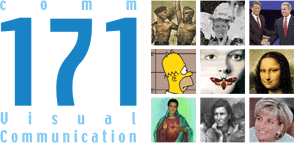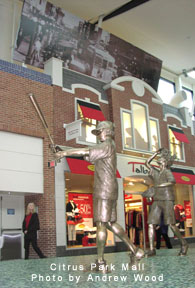
Office: HGH 210; phone: (408) 924-5378
Email: wooda@email.sjsu.edu
Web: http://www.sjsu.edu/faculty/wooda
 |
Dr. Andrew Wood Office: HGH 210; phone: (408) 924-5378 Email: wooda@email.sjsu.edu Web: http://www.sjsu.edu/faculty/wooda |
Reading:
Gottdiener, M. (2001). The theming of America: American dreams, media fantasies, and themed environments. Boulder, CO: Westview.
| Note: These comments are not designed to "summarize" the reading. Rather, they are available to highlight key ideas that will emerge in our classroom discussion. As always, it's best to read the original text to gain full value from the course. |
In our discussion of modern architecture, we've played around the edges of a question of the relationship between form and function. The modern structure evokes the notion that "form ever follows function" - that design and purpose are perfectly linked. The emergence of themed environments introduces an idea that buildings may hide their function - their use as tools of corporate profit-making - underneath a playful form. The key to analyzing this form, according to Gottdiener, emerges in its superficiality. While cultures have always represented their fundamental ideas of truth in their built environments, theme modified milieus of the postmodern era appear to reflect no particular truth at all, only what a Simpsons character announced when he opened Uncle Moe's Family Feedbag: "A whole lotta crazy crap on the walls."

Following his introduction of themed environments, Gottdiener
focuses his attention on themed restaurants, starting with an analysis of roadside
diners in public life in early twentieth-century American auto-culture. These
sites, traditionally a row of chairs and a kitchen counter, transformed into
themed sites marked by chrome and neon. Eventually, fast food restaurants such
as McDonalds offered standardized themes to augment their mass-produced burgers.
Again, Gottdiener emphasizes the role of simulation in these sites, such as
the example of the "fish restaurant disguised as a factory"
(p. 77). Hard Rock Cafe inspired an even more sophisticated forms of themed
restaurant that offered interchangeable meals (often extensions of classic diner
food) in immersive set-pieces transporting patrons to rainforests, biker bars,
and Hollywood sets. Intriguingly, some themed environments strive less for coherence
than an explosion of signs and motifs. One recalls the scene in Pulp Fiction
in which Jack Rabbit Slims offered a range of pop culture references in a single
setting: "Eclecticism and a dizzying postmodern pastiche, rather than historical
accuracy, define this experience" (p. 79). Gottdiener concludes this section
by noting the increasingly suburban nature of themed restaurants, their merger
with a parallel phenomenon: the themed mall.
 Gottdiener
begins his exploration of themed malls by noting their struggle to gain recognition
as a "place" worth visiting - a difficult task given their competition
with downtown department stores that had previously been a focus of urban commerce:
"The grand themed environment of the mall functions as a sign-vehicle that
aids the space's role as a container of many commercial enterprises, because
it is also attractive as a desirable location itself" (p. 91). To obscure
malls' primary goal of profit, designers often clothe their designs in formulaic
motifs that often evoke nostalgia for the small towns that urban and suburban
living have displaced. As a result, malls often seek to simulate towns and cities.
Gottdiener critiques malls as becoming stand-ins for other sites of community,
even as they eschew aspects of religion, cosmology, politics that give meaning
to human life. Instead, one finds within malls a themed environment that conforms
to a set of simulations of public life. Ultimately, Gottdiener questions: where
may one find "America" in the Mall of America?
Gottdiener
begins his exploration of themed malls by noting their struggle to gain recognition
as a "place" worth visiting - a difficult task given their competition
with downtown department stores that had previously been a focus of urban commerce:
"The grand themed environment of the mall functions as a sign-vehicle that
aids the space's role as a container of many commercial enterprises, because
it is also attractive as a desirable location itself" (p. 91). To obscure
malls' primary goal of profit, designers often clothe their designs in formulaic
motifs that often evoke nostalgia for the small towns that urban and suburban
living have displaced. As a result, malls often seek to simulate towns and cities.
Gottdiener critiques malls as becoming stand-ins for other sites of community,
even as they eschew aspects of religion, cosmology, politics that give meaning
to human life. Instead, one finds within malls a themed environment that conforms
to a set of simulations of public life. Ultimately, Gottdiener questions: where
may one find "America" in the Mall of America?
Airports provide the third aspect of environmental theming found in Gottdiener's chapter. Here, airports differ somewhat from the purely profit motive goal of restaurants and shopping malls. Until very recently, few people have found themselves in an airport without having already committed to purchasing a ticket. Thus, airports develop themes to facilitate a different goal: to enable the efficient and (if possible) enjoyable movement of people through their spaces: "The sign systems of terminals . . . are quite explicit in their denotative content. They announce, point, direct, guide, and provide up-to-date information" (p. 95-96). Of course, as airports have been forced to expand their spaces to accommodate larger body jets, the overall theme of terminal-as-train station has given way to terminal-as-shopping mall in which lengthy concourses, navigated with the aid of moving sidewalks, create shopping opportunities every few dozen feet.
[Return]